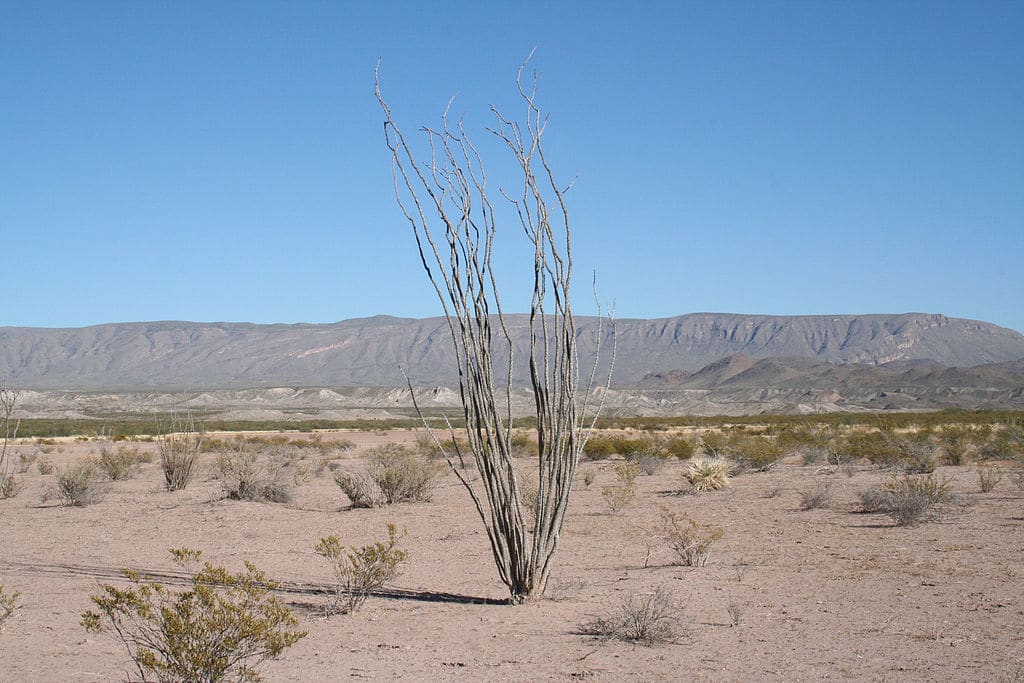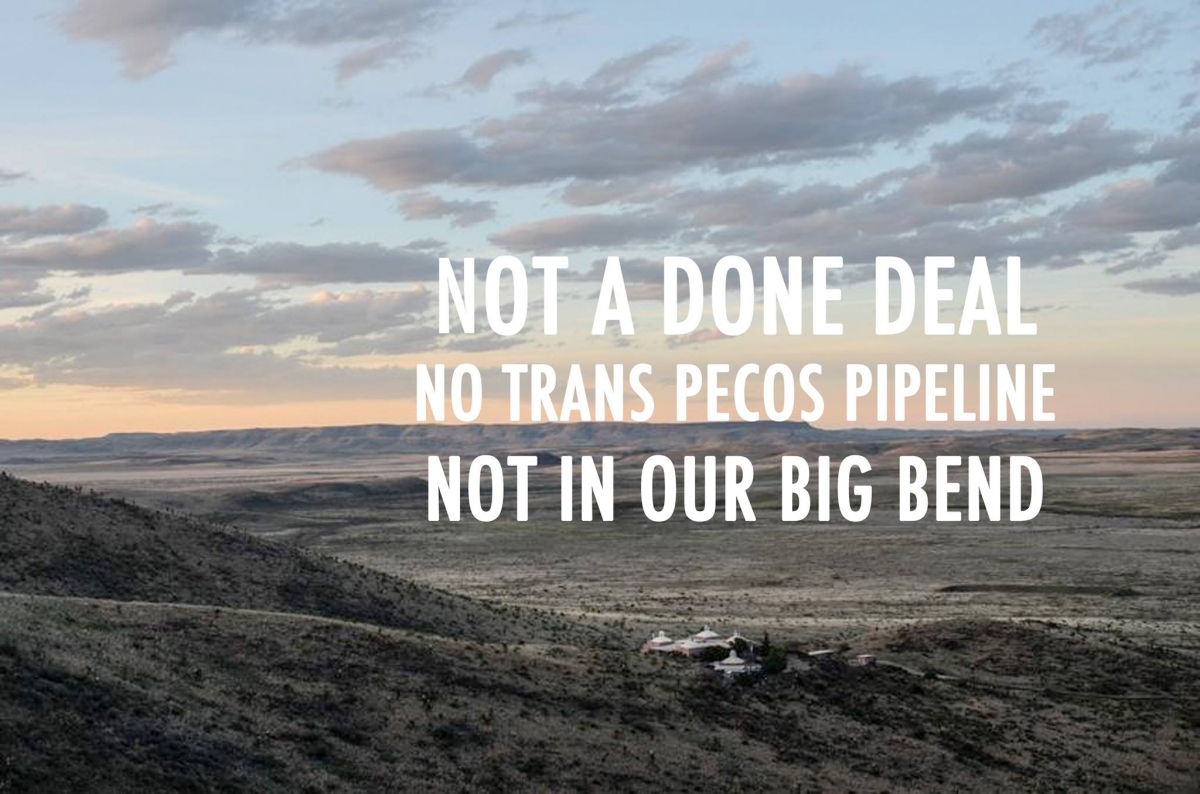Mexico’s landmark energy reforms are already having impacts north of the border, and nowhere more acutely than Texas. One pipeline project in particular is raising hackles in some Far West Texas communities, where residents are troubled by the prospect of hosting a pipeline that would be built for the express purpose of exporting natural gas across the border.
The proposed Trans Pecos pipeline would run from a natural gas hub in Pecos County to the border town of Presidio, where it would connect with another pipeline in Mexican border town Ojinaga to funnel natural gas to Mexico’s interior.
Nestled between the Davis Mountains and Big Bend National Park, the high desert region known as Trans Pecos has become a haven for many Texans who sought to get away from the omnipresence of oil and gas industry and infrastructure in the state. Ranchers and other conservationists in towns like Marfa and Alpine are none too pleased with the prospect of the industry’s arrival in the area, or of assuming all the safety risk for a pipeline that wouldn’t be feeding the energy needs of Texans.
Background on Fracking in Mexico
Natural gas is slated to play a huge role in Mexico’s new energy economy after the overhaul adopted in December of 2013. President Enrique Peña Nieto has announced plans to boost the nation’s natural gas output from current levels of 5.7 billion cubic feet per day to 8 billion by 2018, and to double production within a decade. Natural gas is seen by the administration as essential in powering new industry and new electricity generation.
Mexican officials are looking to foreign companies to bring their hydrofracking expertise to the country’s vast gas fields, many of which lie in the Burgos Basin, just across the border from Texas’ prolific Eagle Ford shale fields.
But until production actually ramps up in Mexico, Pemex, the state-owned and operated energy company, is working to import natural gas to fuel industrial growth and gas-fired power plants.
And so Pemex and Mexico’s Comisión Federal de Electricidad (Federal Electricity Commission, or CFE) are building out infrastructure to support current natural gas needs, and future development.
These include pipelines to import gas from the United States, like Trans Pecos, and others like Los Ramones that run within Mexico to carry the Texas fracked gas to industrial demand centers. Los Ramones, which we covered previously on DeSmogBlog, was officially the first infrastructure project bid out to foreign investors after the landmark energy reforms.
What is the Trans Pecos pipeline?
The Trans Pecos pipeline would run 143 miles from a natural gas hub near the town of Coyanosa in Pecos County down to the border town of Presidio, where it would connect with a short 1,000 foot cross-border pipeline connecting to another line in the Mexican town of Ojinaga. At 42 inches in diameter, it would be capable of moving 1.4 billion cubic feet of natural gas a day.
Waha Hub-Presidio TPP at EveryTrail
Map by Coyne Gibson using EveryTrail
From Ojinaga, the natural gas born in Texas’s Permean Basin would flow through another 42-inch, 120-mile pipeline to El Encino in the northern state of Chihuahua. The Ojinaga-El Encino line was recently bid out to IEnova, the Mexican unit of California-based Sempra Energy.
These are two of a handful of natural gas pipeline projects announced last June by CFE, including three that would operate in the United States to import gas.
Mexico awarded the construction and operation contract for the Trans-Pecos to Dallas-based Energy Transfer Partners, run by pipeline billionaire Kelcy Warren. Warren is partnering on the project with Mexico’s Carlos Slim, the world’s second richest man, according to Forbes.
A West Texas showdown
Ever since the project was formally announced by Mexico’s CFE last year, locals along the proposed pipeline route have been concerned. This concern has grown to all out alarm in recent months, with the imminent reality of private land seizure and an influx of construction workers.
At a packed community meeting in the Big Bend town of Alpine, Mark Glover of the Big Bend Conservation Alliance said, “We’re all here tonight because of a 42-inch gas pipeline that threatens our way of life, our land, and also, our sensibilities on how business ought to be done.”
According to Marfa Public Radio, Glover’s group is working to “build a coalition of landowners, ranchers and progressive environmentalists who see any kind of industry activity here as an existential threat.”
Graphic from the Big Bend Conservation Alliance Facebook page.
In April, Energy Transfer Partners hosted a series of informational meetings to try to rally public support, or at least diffuse public opposition. The 30 reps Energy Transfer sent to the meeting in Alpine were well outnumbered by the more than 200 attendees.
Coyne Gibson, a former engineer within the oil and gas industry, now aligns himself with the Big Bend Conservation Alliance, was present at both Presidio and Alpine meetings, and explained the pipeline company’s PR strategy to the Big Bend Sentinel:
We’re playing ball with experts here. If you’re the pipeline company, you want this to go through, and you’re going to do your best to control the flow of information. You’re going to diffuse the energy of the people that might oppose you. And you’re going to conduct sessions just like this that’s orchestrated by bright, sharp people engaging you directly.
At the meetings, the community members expressed fears of pipeline safety — spills and explosions — and of the potential impact of an influx of temporary construction workers on the quiet communities.
But, predictably, the loudest and most passionate protests came from landowners along the proposed pipeline’s route, who fear their property will be taken by eminent domain.
Pipelines vs. Private Land: Eminent Domain
When it comes to oil and gas pipelines, Texas has some of the country’s weakest private land protections, a particular irony here in Far West Texas where ranchers and property owners are granted remarkably liberal rights to bear arms to protect their private property.
In Texas, companies can seize private land to build pipelines because they are deemed in the “public good.” Pipeline companies are legally classified as “common carriers,” carrying commodities from multiple producers to serve customers who might not otherwise have access.
Pipeline opponents are asking how Trans Pecos would serve the “public good” by exporting gas to customers in Mexico.
Energy Transfer and its contractors have already lost the faith of many local landowners by flouting local laws and courtesies in surveying the pipeline. This spring, a local rancher and former County Judge found a surveyor on her property. “He told us quite unabashedly that he was surveying for the pipeline,” Val Beard told Marfa Public Radio. “We told him he had no permission to be there and would have to vacate the ranch.”
Beard, along with roughly 300 other landowners, had received letters from Legacy Field Services, a surveying company hired by Energy Transfer, with an “ambiguous” request to survey on private property.
One example of the letter, excerpted by the Big Bend Sentinel, stated:
“Trans Pecos Pipeline LLC is developing a natural gas liquids pipeline project in Brewster County, Texas that may cross property in which you have an interest. At this stage of development, Comanche Trail Pipeline LLC is only requesting your permission to conduct surveys on your property to evaluate a potential route.”
“They said they want to do a survey but they didn’t give us any specific information on our property,” Liz Sibley, a letter recipient, told the Big Bend Sentinel. “It was extremely ambiguous, and I think the ambiguity sends out the wrong message.”
According to Beard, no permission was granted. ”It is not only illegal but profoundly discourteous. It’s just not done out here,” she said of the company’s move to survey her land without receiving permission.
Granado Communications, the Dallas-based PR firm working for Energy Transfer, sent an email to the Beards apologizing for the trespass, but landowners like Beard are saying the “whole approach signals bad faith.”
At one of the informational meetings, Energy Transfer reps argued that eminent domain takings would be a “very last resort.” The company, however, has not shied away from seizure in the past, and just this spring sued 17 property owners in Michigan for refusing to allow survey crews on private property.
Getting classified as a “common carrier,” and thus having right to seize private property for a pipeline’s path, is slightly harder today in Texas than it was five years ago.
Before a landmark court case against Denbury Energy in 2011, companies simply had to check a box stating that they are “common carriers.” Now, they have to prove to the public, and to the courts, that they actually do have the right to condemn land for the public good.
Still, it’s an uphill battle against eminent domain for landowners in Texas. No projects have been canceled over private property rights since the court’s decision, and only a few were delayed or re-routed to avoid areas of intense litigation. (Marfa Public Radio has a great overview of eminent domain and pipelines in Texas.)
Pipeline opponents are vowing to defend their private property rights, and a legal battle over eminent domain seems imminent.
Who decides Trans-Pecos’ fate?
Aside from the hyperlocal battles over the pipeline’s route and the right of the company to seize private property, there’s also controversy over how the pipeline will get permitted, and who will regulate its construction and operation.
Energy Transfer Partners has claimed publicly that Trans Pecos is an “intrastate” pipeline, operating and existing within state borders. If so, it would fall under the authority of the Railroad Commission of Texas.
Lisa Dillinger, a spokesperson for Energy Transfer Partners said that the “Texas Railroad Commission has authority over intrastate pipelines, which this pipeline is because it ends custody at the Rio Grande. In that sense it is within Texas.”
The Big Bend Sentinel further explains:
She added that only the 1,000-foot stretch of pipeline required for the border crossing would require a presidential permit, while the remaining 140 miles of pipeline traversing West Texas would require a T-4 form – the standard application for permit to operate a pipeline through Texas – via the Texas Railroad Commission. And from Mexico onward, the pipeline would be subject to Mexican custody.
At the community meeting in Alpine, an Energy Transfer employee told the Sentinel that “the pipeline company had already filed and been approved for its T-4 permit.”
In an email to DeSmog, Railroad Commission spokesperson Ramona Nye confirmed that the T-4 permit was granted:
The Railroad Commission requests that all pipelines file T-4 permits with our agency so that we have information on Texas pipeline locations and the product they are carrying. This permit contained all required information and was submitted correctly, so it was granted.
The Commission had first classified the Trans Pecos as interstate, when a reporter from the Big Bend Sentinel provided a brochure from Energy Transfer:
In an April 8 e-mail, spokesperson for the Texas Railroad Commission Ramona Nye responded with the following: “The Railroad Commission’s pipeline safety jurisdiction applies only to intrastate pipelines that begin and end in Texas. The Energy Transfer flyer you provided me on this pipeline states the pipeline will terminate with an interconnect with a pipeline near Ojinaga, Chihuahua, Mexico, which means this is an interstate and international pipeline under the pipeline safety authority of the U.S. Department of Transportation Pipeline and Hazardous Materials Safety Administration, and the U.S. Department of State. In short, their flyer is incorrect, and we are contacting the company to make a correction.
Nye has since explained to DeSmog that further clarification was sought from Energy Transfer, and with more information from the company, the Commission agreed to categorize the Trans Pecos as intrastate.
When first asked about this proposed pipeline, the Commission originally categorized it as interstate because it physically terminates outside Texas. After further review of federal regulations and with additional information provided by the company, it was determined because ownership of the proposed line terminated within Texas, it would be an intrastate line.
Because of this classification, no federal approval of the project is necessary, and the State Department has no jurisdiction over the Trans Pecos. Nye explained further that:
Railroad Commission rules do not require pipelines to be permitted before being built in Texas. Generally, the Railroad Commission has no authority over the routing or siting of pipelines. The pipeline route is determined by the pipeline’s owner/operator. There is no statutory or regulatory requirement that pipeline operators seek or receive from the Railroad Commission either a determination that there is a need for the pipeline capacity or prior approval to construct a pipeline and related facilities.
In short, because of this intrastate designation, the company has sole responsibility over the route and site of the pipeline. Ultimately, it will be up to the courts to determine if “common carrier” status will stick, and Energy Transfer has the legal authority to condemn and seize private property from the ranchers and conservationists along the pipeline’s route through the Big Bend.
Main image: The Chihuahuan Desert of Big Bend National Park, in the Trans-Pecos region of Texas. Credit: Leaflet, Public Domain
Subscribe to our newsletter
Stay up to date with DeSmog news and alerts







